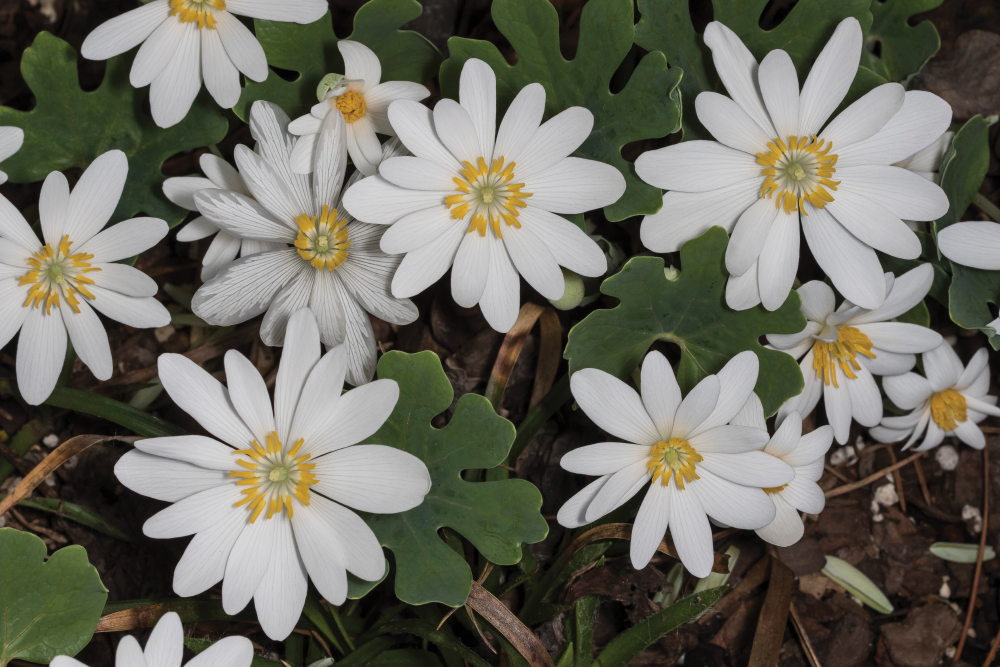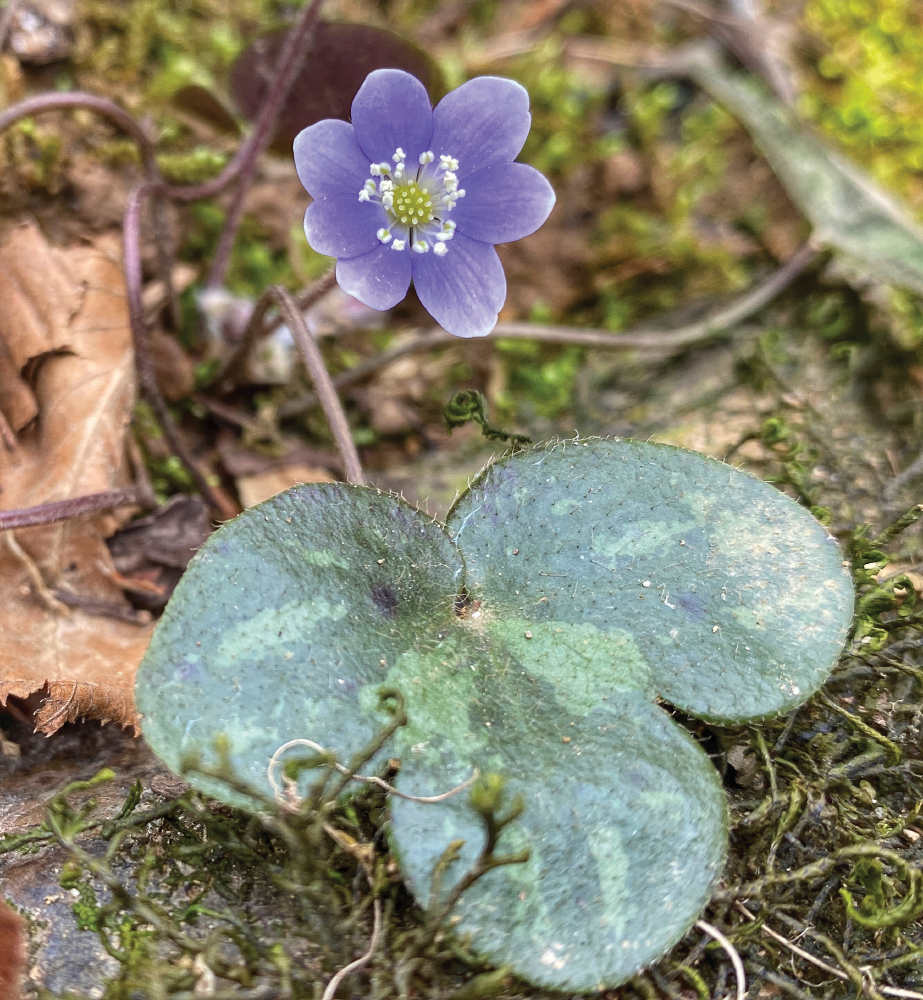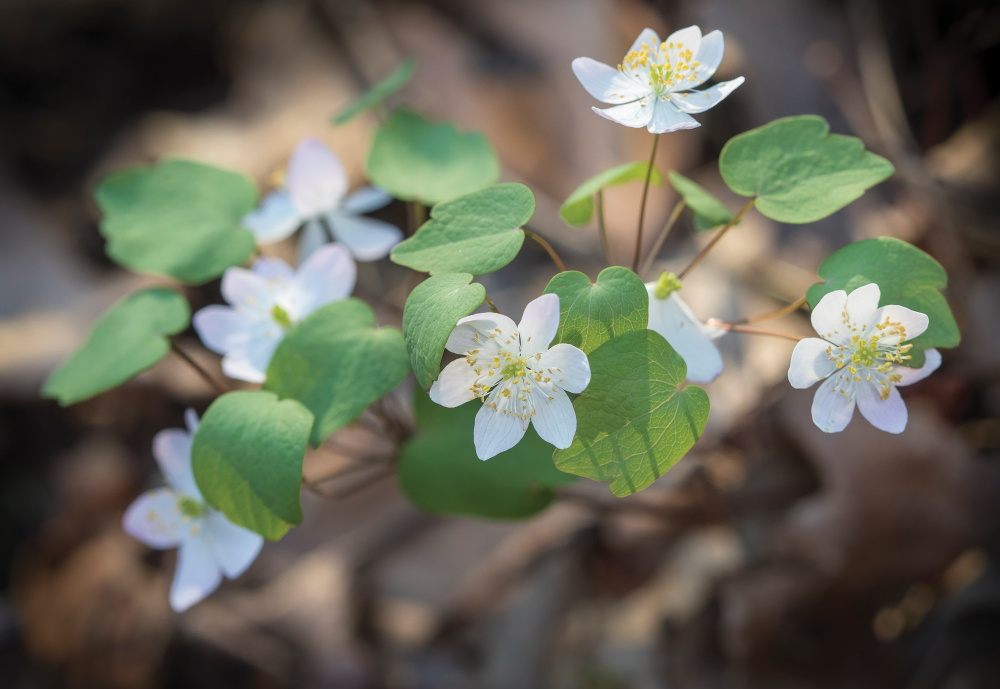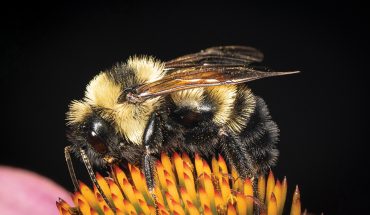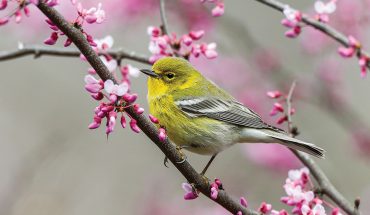Magic happens in the early spring, as sunlight reaches the forest floor — slow down and keep an eye out for these tiny wonders.
Words and photographs by Mike Dunn
These days, the tree branches are still bare in our woods, their winter skeletons exposed, their leaves from last year now covering the forest floor. Grays, browns, and the occasional splash of green from some ferns are the dominant colors. But change is coming.
Starting in late December, more sunlight reaches us with each passing day. In the mornings, I gaze out the window at the native plant shade garden just a few feet from our kitchen, looking for signs of new growth. The spotted leaves of the Trout Lilies should be up any day now. The first Hepatica has shared its purple grace along our creek. Soon, the drab colors of the woods will be dappled with bits of beauty — the first wildflowers of spring.
Spring ephemerals, as these flowers are known, last only a few weeks or months before retreating underground until the next year. They take advantage of increasing sunlight that hits the forest floor before leaves of hardwood trees have a chance to open and cast shade upon the ground. During their brief period aboveground, these wildflowers attract early pollinators and manage to store enough energy underground (in their rhizomes or corms) to ready them for their next appearance. They are found mostly in deciduous forests of North America, Russia, and Japan. North Carolina has an abundance that scatter the forest soil throughout our state, especially in the mountains.
We have a large deer population in our community here in Pittsboro, so spring ephemerals are not particularly abundant in the woods behind our house. Scattered along a creek bottom, our crop is made up of Cutleaf Toothwort, Round-lobed Hepatica, Spring Beauty, Rue Anemone, and a few Giant Chickweed; their tiny petals display shades from snow-white to a gentle violet, lively against a background of verdant leaves. Last year I found the first Hepatica blooming the third week of January, but most of the true spring wildflowers reach their peak from late February to early April.
Inside the deer fence, we have a greater abundance and variety, many of which were obtained through “plant rescues” organized by various conservation groups over the years. A plant rescue is what it sounds like: people going out to a site with permission from the landowners before land clearing or other habitat alteration and digging up plants that would otherwise be destroyed. (It is generally not a good idea to dig up wild plants, but plant rescues are an exception to that rule.) Many of our other plants have been purchased from local native-plant nurseries.
Gardening with spring ephemerals requires patience. Trillium flowers, with their signature three-petaled blooms, may take several years just to germinate from seed. Other flowers, like Trout Lilies, require several years of growth before they flower for the first time. But once you have them, they may be with you many springs. I have one clump of Bloodroot, a perky white blossom with gracefully scalloped leaves, that came from my Great Aunt Ruth’s garden decades ago. She lived in the mountains of Virginia and wildflowers were abundant on her property. Her garden path had a large specimen of this beautiful white flower growing in it and she decided to move it so it would not get trampled. I spent many summers there roaming her property, so she gave that plant to me to look after because she appreciated my naturalist tendencies. It now occupies a prominent spot in our shade garden.
Some of the best places in our area to see spring ephemerals are several of the preserves managed by the Triangle Land Conservancy (TLC), Eno River State Park, the trails in Duke Forest, and the North Carolina Botanical Garden. Look for swaths of Trout Lilies on the slopes and hillsides at places like Swift Creek Bluffs in Cary in late February and early March. Along creek bottoms you can find showy stands of the delicate Spring Beauty about that same time. Late March and April bring another round of spring wildflowers such as Dwarf Crested Iris and Wild Geranium, especially on north-facing slopes. If you miss the show here in the Piedmont, head out to the mountains and visit the Blue Ridge Parkway and Great Smoky Mountains National Park later in the spring.
It’s a good reminder to saunter rather than power-walk through the woods; you’ll need a sharp eye to spot these diminutive wonders, though at times you’ll find them abundant, in showy patches.
These tiny plants are beloved by many — they know spring is coming before we do, appearing even before the beginnings of leaves spark on the trees. And for me, they are a reminder of the wonder of even the smallest things in nature.
__
This article originally appeared in the March 2022 issue of WALTER Magazine.

